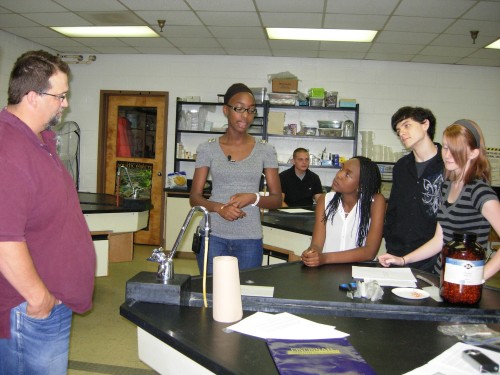
Russell County, Virginia: Student Spaceflight Experiments Program researcher Diana Odhiambo (2nd from left) explains her team’s Mission 2 to ISS flight experiment on the rate of oxidation of copper and iron in a microgravity environment during a local media day. Other research team members are (left to right) Donna Odhiambo, Jakob Akers, and McKenna Collins. Click for Zoom
The way to think about the SSEP flight experiment opportunity is pretty simple, and appropriate for even upper elementary and middle school students—if teachers help them put on their thinking caps. It is worth noting that of the 50 experiments chosen to fly on the first 4 SSEP flight opportunities (STS-134 and STS-135, and Missions 1 and 2 to ISS) 8 were from upper elementary, 18 were from middle school, and 24 were from high school / community college student teams.
We normally observe the characteristics and processes of physical, chemical, and biological systems under the action of gravity on or near the surface of Earth. These systems all experience the “force of gravity” which dictates a number of fundamental phenomena, e.g., that objects and materials weigh something, a sense of up versus down, and that lower density materials will float on higher density materials. These phenomena are intricately connected with how systems behave, and in biological systems, are fundamental to their function (e.g., bone strength requires bone compression under the force of gravity—without it, as in orbit, bone mass is excreted, because it is no longer needed.) Revealing gravity’s role in the behavior of a system can provide a fundamental understanding of how the system operates.
One powerful means of exploring how a system operates, if you have the means to interact with the system, is to recognize that there are many variables involved in its operation. By varying, i.e., temperature, humidity, lighting, concentrations, etc., and varying them in a controlled way, possibly one at a time, you can see the effect on the system in response to a change in variable. But if you want to assess the role of gravity, whose magnitude is defined by the mass of the entire planet Earth, how do you vary it to see the response of the system? Hint: carrying your experiment to the top of a tall building or to the top of a mountain is not effective. There is very little variation in gravity from Earth’s surface to the top of the tallest mountain. And double hint: taking your experiment to the top of an imaginary mountain whose peak is at the orbit of the International Space Station won’t be very effective either, since gravity at that altitude is still 90% of its strength at sea level.
Now for the good part, and one of the key reasons for building the International Space Station. Objects placed in orbit experience “microgravity” often incorrectly referred to as weightlessness, where gravity magically appears to be turned off. Objects truly appear to be weightless – think of the astronauts you’ve seen floating around – which leads to the very incorrect conclusion that there is no force of gravity so high above Earth, hence an object has no weight. But if that were the case, what keeps the International Space Station orbiting the Earth? What keeps the MOON orbiting the Earth? Gravity is very real in space. The reason gravity seems to be absent is not immediately obvious, but it’s because an object in orbit is in a state of continuous free fall—it is a falling object. (Hmmm … what would the bathroom scale you are standing on show if you were in an elevator whose cable had been cut and is free-falling in a very very tall shaft?)
Not convinced? Take time to explore as a class two great resources that provide a deep conceptual understanding of why astronauts appear weightless—
a. NCESSE’s Center Director Jeff Goldstein wrote an enjoyable student challenge on why astronauts appear weightless titled, You Want Me to Take a Bathroom Scale Where?, which teachers and students can read together.
b. NCESSE also developed a great grade 5-8 lesson which easily demonstrates through a hands-on activity that astronauts inside a free falling soda bottle space shuttle appear weightless. The lesson is part of the Building a Permanent Human Presence in Space compendium of lessons for the Center’s Journey through the Universe program. The lesson is titled Grade 5-8 Unit, Lesson 1: Weightlessness, which can be downloaded as a PDF from the Building a Permanent Human Presence in Space page. You can also read an overview of the lesson conducted as part of one of the many Journey through the Universe Educator Workshops, this one in Muncie Indiana.
Here is the cool part. If a physical, chemical, or biological system is brought into a laboratory that is orbiting the Earth, the system will operate as if gravity has been turned off. You’ve removed the gravity variable entirely, and you can see the effect. It is a means to reveal in possibly stark contrast the role of gravity.
Finally, here is the pearl of wisdom, the super sauce, the starting point for your journey. What’s the basic recipe for becoming a real research team designing a real microgravity experiment for the International Space Station? As you navigate through your world on a daily basis, you are knee deep in physical, chemical, and biological systems, and the researcher – the explorer – might ask “How would this system that is interesting to me behave differently if I could turn gravity off? And what might I learn from such an experiment?”
In terms of experimental design, the essential question is:
What phenomenon associated with a physical, chemical, or biological system would I like to explore
with gravity seemingly turned off for a period of time?
Is this an effective question for students? You be the judge. Here are the experiments of the Student Spaceflight Experiment Program.
